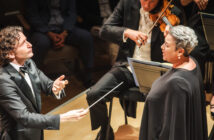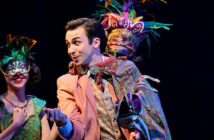Paul E. Robinson
Vivaldi: Concerto in C major for Recorder,
Strings and Continuo RV 444
Vivaldi: Concerto in C major for Recorder,
Strings and Continuo RV 443
Mahler: Symphony No. 6 in A minor
Erik Bosgraaf, recorder
Dallas Symphony Orchestra/Jaap van Zweden
Meyerson Symphony Center
Dallas, Texas
March 1, 2013
It was an interesting weekend. On Friday night, I heard the Dallas Symphony under its music director Jaap van Zweden performing Mahler’s massive Sixth Symphony at the Meyerson SymphonyCenter in preparation for its European tour. The next day I drove 250 miles down I-45 to hear a concert performance of Berg’s opera Wozzeck, one of the last major concerts to be given by Hans Graf as music director of the Houston Symphony.
These two fine performances reminded me that week in and week out, Texas offers some of the most exciting music-making in the country.
In Dallas, whereas most of the evening was taken up with Mahler’s huge Symphony No. 6, which calls for an orchestra of about 120 players, Maestro van Zweden chose to open the concert with two very small pieces at the other extreme of the orchestral spectrum.
The contrast was startling and effective, and it brought to the fore Erik Bosgraaf (photo: right), a thirty-two year old Dutch artist – one of the most remarkable recorder virtuosos I have ever heard – who seems to have fingers as thin as toothpicks. How else to explain how he could rattle off the most difficult passages at lightning speed, on a tiny ‘sopranino’ recorder? How on earth did he find room on the instrument for all his fingers? Admittedly, he is a tall man and his height made the miniature instrument seem even smaller, but it was still a feat to behold. Van Zweden and the strings of the DSO accompanied as if to the manner born, with grace and accuracy.
Mahler’s Massive 6th Symphony in Full Color!
After intermission we got to the main business of the evening: Mahler’s Symphony No. 6, dating from 1903-06. Due to its size and difficulty, the piece was not given its American premiere until 1947.
Mahler was of two minds as to the order of the four movements. The first time he conducted it with the scherzo second and the slow movement third, but later decided they should be reversed. He was also unclear about the instrument that should make the “hammer blow” sounds in the last movement, and left the number of blows to be struck uncertain.
For this Dallas performance, the orchestra followed the lead of the Chicago Symphony, one of whose members had created a wooden box using techniques borrowed from speaker design. The DSO had one constructed by the same maker and used it in the performance I heard.
Principal percussionist Doug Howard (photo: right) did the “hammer” honors with a dash of theatricality, getting to his feet a page or so before the blows are to be struck, then raising the huge hammer over his head and bringing it down on the box with all the authority he could muster. He wore gloves, presumably to cushion his hands and wrists, which made him look a little like an executioner! And how many hammer blows were there? Van Zweden decided that two were sufficient, whereas some conductors prefer three. No matter; one could argue that this issue is only significant if one gives these blows an excessively autobiographical interpretation.
Maestro van Zweden had already programmed the Mahler Sixth in Dallas a few seasons back and those performances were outstanding. It made very good sense to bring the piece back for further refinement and to show the results to Europe on the forthcoming tour; moreover, there is no doubt that the DSO is a better orchestra than it was a few years ago, thanks to major changes in personnel and forceful work by van Zweden on the podium.
From the opening bars of the first movement, van Zweden made it clear that the edgy intensity of the music was going to be fully realized. He and his players were totally involved and drove the music inexorably forward. There are moments of relaxation in the movement as well, and these were played with tenderness and beauty. The horn solos were very well executed by guest principal Gail Williams, formerly of the Chicago Symphony. The cowbells, unfortunately, were all but inaudible. The Andante moderato was sublime from beginning to end, with exquisite soft playing from the violins. The last movement was shattering in its ferocity.
All in all, a great triumph for van Zweden and the DSO in Dallas, and if the tour concerts come anywhere close to this standard, European audiences are in for something special.
Standing Ovation for Graf/HSO Wozzeck!
Berg: Wozzeck
Roman Trekel: Wozzeck
Anne Schwanewilms: Marie
Gordon Gietz: Drum Major
Marc Molomot: Captain
Nathan Berg: Doctor
Katherine Ciesinski: Margaret
Houston Symphony Orchestra/Hans Graf
Jones Hall
Houston, Texas
March 2, 2013
While both the Dallas Symphony and the Houston Symphony (HSO) have had financial difficulties in recent years, each organization has pulled itself together and emerged with even stronger artistic credentials. The Eschenbach years (1988-1999) were a kind of ‘Golden Age’ for the Houston Symphony and after he left the orchestra struggled both financially and artistically; music director Hans Graf (above: left) toughed it out, however, demonstrating true leadership and mastery of a wide repertoire.
Last week, Graf conducted a semi-staged performance of Berg’s opera Wozzeck. Musically, the results were at the highest level, with German soprano Anne Schwanewilms (photo: right) particularly impressive as Marie. The orchestra had been meticulously prepared and one often heard details lost in opera house productions.
The stage presentation, on the other hand, was disappointing. For these performances in Jones Hall, the orchestra was pushed to the rear of the stage to create a playing area in front for the singers, the direction of whose movements was little more than perfunctory.
This task had been assigned to Kristin L. Johnson, the HSO’s Director of Operations and Production, who seemed to have neither the imagination nor the skills to do the assignment justice. Statements in the printed materials accompanying the program offered the opinion that a concert performance of Wozzeck allows audience members to use their imagination more freely. That said, this opera nevertheless cries out for a vivid realization of theatrical elements; costumes, set pieces, lighting and stage direction that illuminates the story all have important roles to play in bringing Wozzeck to life, in a staged “concert” version as much as in a fully staged production.
Perhaps this Houston Wozzeck suffered from budget constraints, with more money going into orchestra rehearsal than to staging. Understandable – but in my opinion, the emotional impact of the piece was unfortunately undermined not by dollars, but by choices, such as somewhat mindless staging, and inattention to costuming and set pieces. Multi-media effects may have been beyond the budget, but could well have enhanced this presentation.
These observations aside, The Houston Symphony deserves credit for programming a complete Wozzeck in any form whatsoever. This work is still a tough sell for most symphony audiences, which makes this HSO presentation an anomaly, perhaps, considering that the performance I attended appeared virtually sold out and very few patrons left the hall until it was over. The HSO also went the extra mile in preparing promotional materials for Wozzeck; the video and the booklet were both truly illuminating.
Maestro Graf is coming to the end of his last season as music director of the Houston Symphony – he has been here 12 years – but he will return in future seasons as conductor laureate.
Next season the orchestra will celebrate its 100th anniversary. Former music director Christoph Eschenbach will return for two performances of Mahler’s Symphony No. 8 in May, 2014. Music Director Designate Andres Orozco-Estrada will lead four programs.
Paul Robinson is the author of Herbert von Karajan: the Maestro as Superstar, and Sir Georg Solti: His Life and Music. For friends: The Art of the Conductor podcast, “Classical Airs.”














